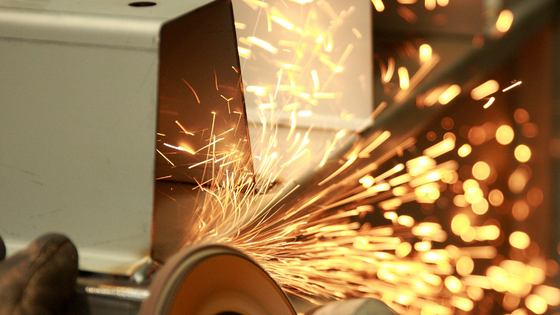
Reports indicate that as demand in the automotive and construction sectors continues to increase, we should also expect steady growth in the precision steel fabrication market over the next several years. That growth means increased demand for stainless steel as it holds the largest market share in American precision steel fabrication. To understand what makes stainless steel the most popular choice of fabricated metals, let’s review how stainless is made, what it is used for, and its potential benefits.
While steel is a metal alloy composed mainly of iron and carbon, stainless steel also contains at least 10.5% chromium. To further enhance the mechanical properties of stainless steel, elements like manganese, molybdenum, nickel, and titanium may also be added. Various types and grades of stainless steel are produced depending on the ratio of the raw materials combined.
Kloeckner Metals is a full-line stainless steel supplier and service center. Download our stainless steel spec sheet today and check what Kloeckner Metals routinely stocks.
The five types of stainless steel are:
There are various grades of stainless steel within the types mentioned above. You can read more in our short guide to grades of stainless steel.
Metal fabrication is the manufacturing process in which metal is cut, bent, shaped, and assembled to create various end products. This value-add process creates different parts, machines, and structures widely utilized by the general public.
The first step in fabricating stainless steel is melting the raw materials into liquid steel. This process typically takes 8 to 12 hours of sustained, intense heat in an electric furnace. Then, to ensure high-quality output, the liquid metal is stirred to remove any impurities before being cast into semi-finished forms, including blooms, billets, slabs, rods, and tubes.
Next, the stainless steel undergoes a series of forming or shaping techniques. The stainless steel is heated, passed through large rolls, and formed into shapes. During hot rolling, blooms and billets are converted to rods or wire, while slabs become sheets, strips, and plates.
Now that the stainless steel has taken form, the annealing (heat treatment) process occurs; the steel is heated and cooled within controlled conditions to alleviate internal stresses.
Because the annealing process can cause a build-up (scaling) to form on the steel, a descaling process, like pickling or electrocleaning, must be used to reverse the effects. (Depending on the type of stainless steel manufactured and whether hot rolling or cold rolling was used during formation, annealing and descaling may occur at varying points during fabrication. More information on descaling can be found at ASTM International.)
Cutting operations begin to create the desired shape or size required for the final output. This step in fabrication can be accomplished by various methods, including laser cutting (most common), sawing, flame cutting, plasma jet cutting, nibbling, blanking, straight shearing, or circle shearing.

The surface finish is a critical specification to identify before the finishing phase. Depending on the desired type of stainless steel finish, the finishing process may include buffing, grinding, or polishing.
Once the stainless steel has been finished per the specifications, it is delivered to the end user, who will further shape, weld, and join the steel to produce the desired end product.
Widely used in commercial, residential, and industrial settings, stainless steel has many properties that make it a top choice of manufacturers, including:
With the addition of chromium and other alloys, stainless steel is corrosion resistant, fire resistant, and has a low susceptibility to brittleness at extreme temperatures. It retains its shape and composition nicely under even the most adverse conditions.
Due to its smooth, non-porous surface, stainless steel is easily sanitized and does not provide a desirable environment for bacteria to prosper.

Stainless steel has long been the preferred choice in commercial or residential settings due to its clean architectural aesthetic.
Stainless steel is 100% recyclable. Since a vast majority is already produced from recycled materials, the need for further mining is reduced. As an added environmental benefit, stainless steel does not leach toxic chemicals.
Due to consistent marketplace demand, the price for stainless steel remains competitive. While the initial investment may appear more expensive than comparative metals, the lower fabrication, installation, and maintenance costs, long-term durability, and recyclability help keep the whole life cycle cost lower.
Stainless steel is found in a variety of widely-used equipment and products. Below are a few specific examples of the various ways stainless steel is used:
Stainless steel is commonly found in our homes in tools, cutlery, cookware, appliances, sinks, and washing machines.
Stainless steel is both functional and fashionable. Due to its strength and corrosion-resistant properties, stainless steel is a popular choice used worldwide in the construction and architectural elements of commercial buildings and bridges. Additionally, it is used in commercial kitchens and bathrooms because of its durability, aesthetics, cost-effectiveness, and hygienic properties.
Every transportation sector benefits from the fabrication of stainless steel. Whether traveling by land, air, or sea, stainless steel components are found in automotive, rail, marine, and aerospace vehicles.
The hygienic characteristics of stainless steel make it a favorable choice when producing medical tools and devices, including hypodermic needles, implants, stents, and more.
Multiple energy sectors, including oil, gas, solar, hydro, geothermal, and wind, use stainless steel for various components involved in production and distribution. It is an integral part of energy production due to its corrosion- and heat-resistant properties.
The food service industry relies on stainless steel because of its sanitary design and corrosion resistance. Additionally, stainless steel does not alter the flavor of the food, is cost-effective, and is easily recyclable. It is used in commercial pasteurizers, cookers, and refrigeration units and serves as the bottling agent for beer, soft drinks, juices, and more.
Kloeckner Metals is a full-line stainless steel supplier and service center. Kloeckner Metals combines a national footprint with the latest fabrication and processing technologies and most innovative customer service solutions.

Steel base plates are fundamental elements employed in various manufacturing...
Metal fabrication is a critical process that transforms raw metal...
The solar industry has undergone a significant transformation by incorporating...

X
The Kloeckner Metals website uses modern technologies. Unfortunately, your browser doesn't support those technologies.
Download the latest version of one of these browsers to experience the site: